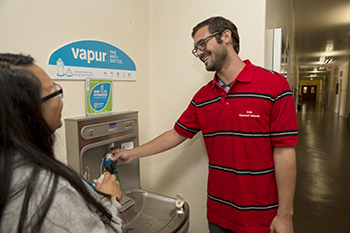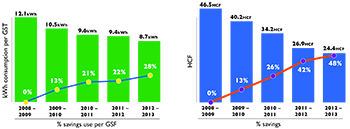Sustainability Efforts at CI

By Carissa Collinge, Facilities Services Sustainability Assistant, ’13 Communication & Political Science; and Austin Eriksson, Facilities Services Sustainability & Operations Analyst, ’13 Environmental Studies & Resource Management
Over the last several years, sustainability has become one of the University’s strategic goals and in 2009 the Going Green project was launched towards promoting sustainability education as well as initiatives. Primary areas of focus have included energy conservation, landscaping, waste minimization, water conservation, and most recently, communication.
Energy Conservation
CI has made great progress in the area of energy conservation. Some recent energy-focused projects include new, more efficient lighting in Napa Hall, Energy-Star benchmarking for use in the campus building portfolio through a student Capstone project, a lighting upgrade on Santa Barbara Street, and ongoing operations and maintenance optimization. Due to these projects and many others, the University has been able to increase energy savings by 28% since 2009 (see Electricity Use Chart).
Landscaping
Traditional landscaping throughout the campus is being replaced with drought-tolerant landscaping and many native plant species are being propagated in the campus green house and University Park. Currently, 99% of the campus is irrigated with reclaimed water saving thousands of gallons of potable water every year and no chemical fertilizers are being used thereby eliminating the risk of toxicity leaking into the surrounding environment. Long Grade Creek, a wetlands habitat located on the campus, has been under continuous restoration so that native plants and animal species may thrive. For its efforts, CI gained the prestigious “Tree Campus USA” designation, one of 150 campuses nationwide and the first in the CSU system.
Waste Minimization
The University has been able to achieve a 60% recycling rate with the installation of 29 recycling units throughout the campus and participation in the EPA WasteWise program. CI is also actively composting waste by participating in a pilot program that converts food waste into compost and by composting 100% of green waste. Hydration stations have been installed throughout the campus, which encourage the use of reusable water bottles.

Water Conservation
As stated earlier, CI practices extreme efficiency in potable and reclaimed water use with over 99% of the campus being irrigated with reclaimed water. The University has also saved 40,000 gallons of water per year as a result of waterless urinals, which equates to a remarkable 48% savings in domestic water consumption since 2009 (see Domestic Water Consumption Chart). Additional savings will be achieved by low-flow fixtures being tested in Student Housing with possible installation campus-wide.
Communication
In spring of 2013, a new Sustainability Communication Plan was developed to increase dialogue about sustainability in order to create exposure, awareness, action, and commitment throughout the campus community. For regular updates on campus sustainability and opportunities for involvement, follow SustainableCI on Facebook, Twitter, and Instagram.
